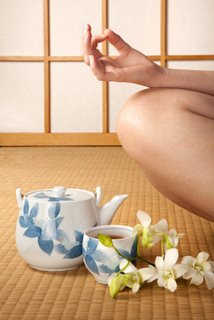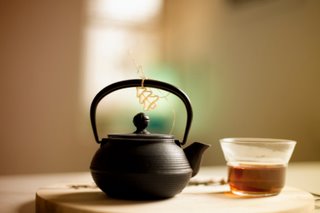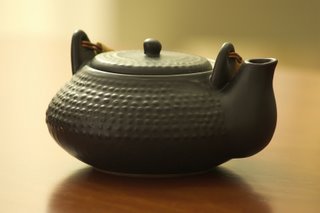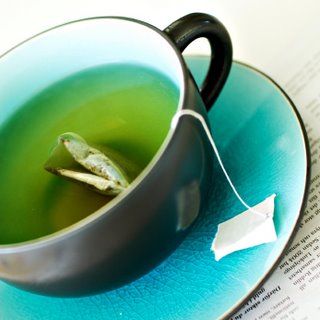
tea and yoga
Enjoyed for centuries as a healthy drink, tea also has merits as a postyoga refreshment with the ability to foster community and dialogue among students—while soothing the senses, too.
By Angela Pirisi
When students are roused from their final relaxation after a yoga session and you see them emerge glowing and peaceful from the stillness of their mat, the last thing you want to do is turn them out into the noise, chaos, and stress of the world outside the studio. It’s too jolting a contrast, and students often need some time to digest their yogic experience and slowly transition back to their daily lives. That’s why, for many yoga studios, the bridge between yoga and the high-intensity pace outside is a warm cup of tea.
Serving Health and History
Many studios serve tea, usually after class, as a way to offer students an opportunity to bask in the buzz of yoga. “People’s hearts are really opened after yoga, and tea offers a perfect segue back into their reality,” says Elissa Kerhulas, a Kundalini teacher and owner of Yoga Brew in Hollywood, California. Tea is an informal yoga tradition that has taken root over the years, and growing knowledge about the various health benefits of tea have made it a welcome addition to yoga classes as one more way to embrace healthy living. While it’s not a ritualized process per se, the tradition of combining tea and yoga has an ancient connection.
“Yoga and Ayurvedic medicine go hand in hand,” says Kerhulas, who offers tea (and/or soup) as part of her home-catered yoga classes. She remembers her Kundalini teachers talking about tea all the time. For example, “yogi tea,” a home-brewed spice tea, includes traditional Ayurvedicspices, such cloves, black pepper, cinnamon, cardamom, and ginger, in a black tea base, sweetened with milk and honey. The recipe was inspired in the 1960s by Yogi Bhajan, who served the tea to students. Many teachers, though, have stepped away from this traditional recipe and are serving up drinks that range from green tea to roasted barley to custom herbal blends.

yoga and tea
Kerhulas was brewing her own custom blends when she started her business six years ago, but she then started consulting a master herbalist who now intuitively assesses the best brew for each of her classes. “The kind of tea I serve depends on the people in a class, as well as the time of day,” Kerhulas explains. “For morning classes, I might start with something such as chai, ginger, or yogi tea because of their invigorating and stimulating properties. For evening classes, I would more likely choose something calming or grounding, such as jasmine, lavender, wood betony (mint family), licorice, or chamomile.” Her one-of-a-kind tea blends often combine several herbs.
Melanie Smith, an Anusara yoga teacher and owner of Yogaphoria in New Hope, Pennsylvania, offers students custom-blended teas made just for her studio, including black, green, and Rooibos teas. “Serving tea arose from the desire to serve something healthy and nurturing,” she says. On a more personal level, though, adds Smith, “I’m a big fan of tea and what it can do for the body—its healing properties and antioxidants.”
Opening Hearts and Minds
Besides soothing and healing properties, the main thrust behind a postyoga cup of tea is about the social bonding and unity it creates among students. “It’s very much about community, a chance to get to know each other, as well as a chance to be part of that energy and keep that energy, too,” says Smith. Her studio includes a space created specifically for tea, the Tea Lounge. She describes it as a place where students can study, do their work, and process what they’ve learned in classes or teacher training.
Other teachers agree that tea can help facilitate learning and discussion. Jennifer Durand, who teaches hatha yoga at the Healing Yoga Foundation in San Francisco, leads the Ladies’ Tea and Yoga Society, where students convene after her hour-long class for tea and philosophical discussion, either in the studio, which is an old greenhouse, or in the garden. Durand describes these gatherings as significantly more social than, say, a Japanese tea ceremony. “When everyone has settled, I either introduce a topic of discussion (anything from a Yoga Sutra to how we can eat more healthfully) or I let the conversation unfold on its own. Increasingly, I’ve been choosing the latter, as it seems to me that the women are enjoying the chance to connect in their own way,” says Durand.

tea
“The way the Society came about was that, of course, hatha yoga gets you only so far—it gives you a certain discipline, to be sure, and it can create a stronger, healthier body,” explains Durand. “But one must take it that extra distance for the practice to be truly transformative; one has to delve into the philosophical side of things. I find the best way to introduce the Sutra is through the gentle approach of sneaking it in with tea and treats.”
Whether used for its mystical or medicinal properties, tea has become an integral part of yoga, and students seem to have no trouble warming up to the experience.
Tips for Serving Tea
While there is no rule book for serving tea with yoga, there are some ways to enrich the experience by setting the right mood.
Invite all of the senses. Kerhulas stresses maintaining a clean, uncluttered space; adding beautiful objects (flowers, artwork); serving tea in a porcelain or wooden cup; playing light, meditative music; and using incense, such as sandalwood (which is very grounding). “Basically, it needs to feel as if you are entering a special zone that’s separate from the stresses of everyday life,” she says.
Serve only the finest tea. “Make sure to use good, loose-leaf tea to enhance the whole experience—it’s more healing and beneficial,” says Smith. On a practical note, Smith advises that if you want to use fine china, you have to clear it with the local health department. In fact, Smith says she has a restaurant license just to brew and serve tea. Using any nondisposable dishes or cutlery would require having a dishwasher and a three-basin sink. In Pennsylvania, where she is, you’re regulated as soon as you serve anything—the law could vary across the states.
Make it comfortable. It’s about creating a space where students feel welcome, loved, and nurtured, says Smith. That’s why she chose to place a large, L-shaped, lavender sofa in her Tea Lounge, custom-designed to be extra deep so students could easily sit on it in the Lotus position. Both the sofa and room are decorated with soothing, soft shades, such as sage, turmeric, and saffron.

tea
Pair it up with healthy food. Kerhulas serves homemade vegetarian or vegan soups (such as black bean, curried butternut squash, or potato leek). Smith says the Tea Lounge sells only green, raw, or organic snack bars and fruit—”things that enhance health, nothing processed.”
The guidelines vary by state, and maybe even by city or town, but Smith suggests that once you’re preparing and serving food or drink, you’re starting a relationship with the health department. And if you aren’t following the local laws and you’re found out, you can be reprimanded, fined, or even shut down. The best policy is transparency. Call your local health department; tell them exactly what you’re planning to do, serve, and sell; and then fill out the proper paperwork. Your best bet is to follow all relevant laws.
Angela Pirisi is a freelance health writer who has covered holistic health, fitness, nutrition, and herbal remedies. Her work has appeared in Yoga Journal as well as inNatural Health, Fitness, Cooking Light, Let’s Live, and Better Nutrition.

bowl gong timers for tea, yoga and meditation
Now & Zen, Inc.
1638 Pearl St.
Boulder, CO 80302
(800) 779-6383
adapted from Yoga Journal.com
Posted in Tea Ceremony, teahouse